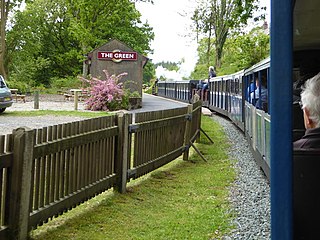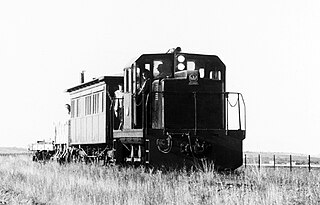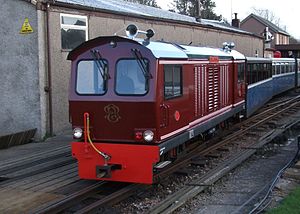
The Ravenglass and Eskdale Railway is a 15 in minimum gauge heritage railway in Cumbria, England. The 7-mile (11.3 km) line runs from Ravenglass to Dalegarth Station near Boot in the valley of Eskdale, in the Lake District. At Ravenglass the line ends at Ravenglass railway station on the Cumbrian Coast Line.

The Snowdon Mountain Railway is a narrow gauge rack-and-pinion mountain railway in Gwynedd, north-west Wales. It is a tourist railway that travels for 4.7 miles (7.6 km) from Llanberis to the summit of Snowdon, the highest peak in Wales.

Pichi Richi Railway is a 39 kilometres narrow-gauge heritage railway in the southern Flinders Ranges of South Australia between Quorn and Port Augusta. For much of its length the line lies in the picturesque Pichi Richi Pass, where the line was completed in 1879 as work proceeded north to build a railway to the "Red Centre" of Australia – the Central Australia Railway.

Ravenglass is a railway station on the Cumbrian Coast Line, which runs between Carlisle and Barrow-in-Furness. The station, situated 29+1⁄4 miles (47 km) north-west of Barrow-in-Furness, serves the village of Ravenglass in Cumbria. It is owned by Network Rail and managed by Northern Trains.

The Duffield Bank Railway was built by Sir Arthur Percival Heywood in the grounds of his house on a hillside overlooking Duffield, Derbyshire in 1874. Although the Ordnance Survey map circa 1880 does not show the railway itself, it does show two tunnels and two signal posts. However, the online map archive of the National Library of Scotland includes a map of 1914 from the 25 inches to the foot series that shows the full extent of the railway.

Douglas Martin Edward Ferreira, O.B.E., (1929–2003) was the longest-serving general manager of the Ravenglass & Eskdale Railway, a heritage railway in Cumbria, England known as the "Ratty". He was at the heart of the "Ratty" for 34 years.

The Eaton Hall Railway was an early 15 in gauge minimum gauge estate railway built in 1896 at Eaton Hall in Cheshire. The line, which connected the Grosvenor estate with sidings at Balderton on the GWR Shrewsbury to Chester Line about 3 miles (4.8 km) away, opened in 1896. It was built for the Duke of Westminster by Sir Arthur Percival Heywood, who had pioneered the use of 15 in gauge with his Duffield Bank Railway at his house at Duffield, Derbyshire in 1874.
The Heart of Dixie Railroad Museum is the official state railroad museum of Alabama. Dedicated to the preservation, restoration, and operation of historically significant railway equipment, the museum is located at 1919 Ninth Street, Calera, Alabama, on I-65 approximately 30 miles (48 km) south of Birmingham.

TMA Engineering Ltd, is an engineering business based in Erdington, West Midlands, who supply services around power presses, but are best known for their sideline in building and overhauling miniature steam locomotives.

The 15 in gauge, single track Lakeside Miniature Railway runs along the seaward side of the Marine Lake in Southport, England.

Irton Road railway station is a railway station on the 15 in gauge Ravenglass & Eskdale Railway in the Lake District National Park and the English county of Cumbria. The station is situated on the western edge of the village of Eskdale Green. It is some 4 miles (6.4 km) from Ravenglass and 3 miles (4.8 km) from Dalegarth for Boot, and trains take 20 minutes to reach their destinations in either direction from this station.

The Green is a railway station on the 15-inch gauge Ravenglass & Eskdale Railway in the Lake District National Park and the English county of Cumbria. The station is situated on the southern edge of the village of Eskdale Green, overlooking the Eskdale valley and Muncaster Fell. It was originally known as King of Prussia after the nearby public house, and later as Eskdale Green. The Eskdale Green name has continued in popular use, and was still in official use in 2017 in the railway's "full" timetable of intermediate stopping places.

Ravenglass Heritage Railway Station is the Western terminus of the Ravenglass and Eskdale Railway. It is situated to the east of Ravenglass main line railway station, which is on the Cumbrian Coast Line. The facilities at the railway station include toilets, under-cover platforms, booking office and café. The railway station complex incorporates 2 locomotive sheds, a carriage shed, a signal box, managerial offices and 2 camping coaches; along with the railway station itself.

Fisherground railway station, also known as Fisherground Halt, is on the 15-inch (380 mm) gauge Ravenglass & Eskdale Railway in Cumbria, England. Its main purpose is to serve the adjoining camp site. A passing loop is situated 100 metres (330 ft) to the west of the halt, whilst a no longer used water tank is situated at the halt itself.

Dalegarth railway station is the easterly terminus of the 15-inch gauge Ravenglass and Eskdale Railway in Cumbria, England. It has a café and shop for passengers, along with a run-round loop, turntable and siding for trains. It is located next to the Whillan Beck, a tributary of the River Esk flowing from the isolated Burnmoor Tarn.
Henry Greenly (1876–1947) was amongst the foremost miniature railway engineers of the 20th century, remembered as a master of engineering design.

The Shuzenji Romney Railway is a 1.2 km, 15 in gauge ridable miniature railway located in Niji-no-Sato in Izu, Shizuoka, on the Izu Peninsula in Japan. It is based on the English Romney, Hythe & Dymchurch Railway on the English Channel coast in Kent, which opened in 1927. The railway operates using a mixture of steam and diesel locomotives and enclosed saloon carriages. Its primary two steam engines were built by the Ravenglass and Eskdale Railway in Cumbria, England, and are based on that line's 1976 Northern Rock 2-6-2 steam locomotive. Its No. 2 locomotive Ernest W. Twining was acquired from the Fairbourne Railway in Wales when that line converted to 12+1⁄4 in gauge. There is also a small 15-inch gauge railway museum.

This article gives details of the locomotives used on the Ravenglass and Eskdale Railway, a 15 in narrow gauge preserved railway line running for 7 miles (11 km) from Ravenglass on the Cumbrian coast to Dalegarth near the village of Boot, in Eskdale.

The Commonwealth Railways NC class consisted of two diesel-hydraulic locomotives built by Clyde Engineering, Granville, New South Wales in 1956. The Lakewood Firewood Company, Kalgoorlie was the first owner; the Commonwealth Railways purchased them in 1965. They ceased revenue service in the early 1980s.

The Heatherslaw Light Railway is a 15 in gauge passenger carrying railway near Ford, Northumberland, England, close to the border with Scotland.


















